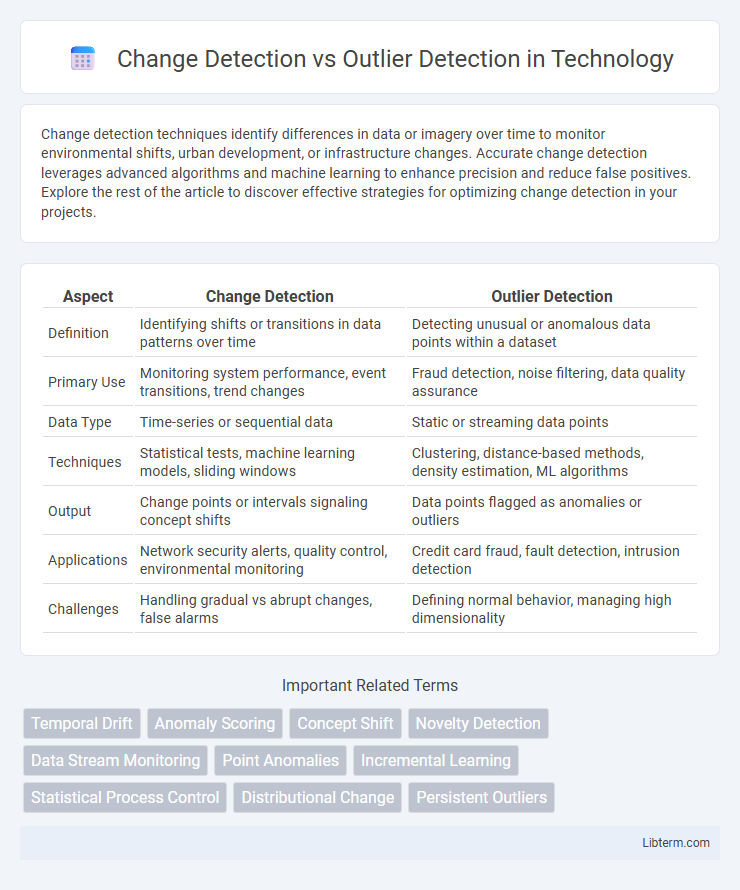Change detection techniques identify differences in data or imagery over time to monitor environmental shifts, urban development, or infrastructure changes. Accurate change detection leverages advanced algorithms and machine learning to enhance precision and reduce false positives. Explore the rest of the article to discover effective strategies for optimizing change detection in your projects.
Table of Comparison
| Aspect | Change Detection | Outlier Detection |
|---|---|---|
| Definition | Identifying shifts or transitions in data patterns over time | Detecting unusual or anomalous data points within a dataset |
| Primary Use | Monitoring system performance, event transitions, trend changes | Fraud detection, noise filtering, data quality assurance |
| Data Type | Time-series or sequential data | Static or streaming data points |
| Techniques | Statistical tests, machine learning models, sliding windows | Clustering, distance-based methods, density estimation, ML algorithms |
| Output | Change points or intervals signaling concept shifts | Data points flagged as anomalies or outliers |
| Applications | Network security alerts, quality control, environmental monitoring | Credit card fraud, fault detection, intrusion detection |
| Challenges | Handling gradual vs abrupt changes, false alarms | Defining normal behavior, managing high dimensionality |
Introduction to Change Detection and Outlier Detection
Change detection identifies significant alterations in data patterns over time, crucial for tracking system behaviors and environmental shifts, while outlier detection targets anomalous data points that deviate from the norm, signaling potential errors or rare events. Both techniques play complementary roles in data analysis, enhancing the accuracy of predictive models and decision-making processes. Implementing robust algorithms for these tasks improves anomaly recognition and supports adaptive system responses.
Defining Change Detection
Change detection refers to the process of identifying significant shifts or transformations in data patterns over time, often used in time series analysis, remote sensing, and image processing applications. This method focuses on recognizing meaningful changes in the underlying data distribution or structure, distinguishing it from random noise or variations. Unlike outlier detection, which targets isolated anomalies or rare events, change detection emphasizes broader temporal or spatial alterations indicative of evolving trends or conditions.
Defining Outlier Detection
Outlier detection identifies data points that significantly deviate from the majority, indicating anomalies or rare events within a dataset. It focuses on pinpointing individual or isolated instances that differ in value, behavior, or pattern, often used in fraud detection, network security, and fault diagnosis. Unlike change detection, which monitors shifts over time, outlier detection emphasizes spotting unusual data within a static or dynamic dataset.
Key Differences Between Change Detection and Outlier Detection
Change detection identifies significant shifts or trends in time series or spatial data over intervals, focusing on transitions in data patterns. Outlier detection targets individual data points or events that deviate markedly from the norm within a dataset, emphasizing anomalies at a granular level. While change detection examines structural data alterations over time or space, outlier detection highlights isolated irregularities without necessarily indicating a broader pattern shift.
Techniques Used in Change Detection
Change detection techniques primarily rely on statistical methods, machine learning algorithms, and deep learning models to identify significant differences in data over time, such as temporal image differencing, cumulative sum (CUSUM), and Bayesian change point detection. These methods analyze variations in data distribution, patterns, or features to detect shifts indicative of change, often leveraging time series analysis, clustering, or classification approaches. Change detection is distinct from outlier detection, which focuses on identifying rare or anomalous data points within a single dataset rather than tracking changes across datasets or time intervals.
Techniques Used in Outlier Detection
Outlier detection techniques primarily rely on statistical methods, distance-based approaches, and machine learning algorithms to identify anomalies within datasets. Common techniques include clustering methods such as DBSCAN, statistical tests like Z-score or Grubbs' test, and model-based approaches including Isolation Forest and One-Class SVM. These techniques focus on distinguishing data points that deviate significantly from the norm, enabling effective identification of unusual patterns or rare events.
Common Applications of Change Detection
Change detection is commonly applied in environmental monitoring, such as tracking deforestation, urban expansion, and climate-driven land cover changes using satellite imagery. It also plays a critical role in infrastructure management by identifying structural changes or damage in bridges, roads, and buildings through sensor data analysis. These applications leverage temporal data comparisons to detect significant alterations, enabling proactive responses and informed decision-making across various industries.
Common Applications of Outlier Detection
Outlier detection is commonly applied in fraud detection within finance, identifying abnormal transactions that deviate from typical behavior. It also plays a crucial role in network security by spotting intrusions or unusual activity patterns indicating potential cyber threats. In healthcare, outlier detection helps identify rare diseases or diagnostic anomalies, improving patient outcomes through early intervention.
Challenges and Limitations
Change detection faces challenges related to distinguishing genuine changes from noise in dynamic environments, requiring robust algorithms capable of handling varying data distributions and temporal dependencies. Outlier detection struggles with defining what constitutes an outlier in diverse datasets, often leading to high false positive rates and sensitivity to parameter settings. Both methodologies are limited by the scarcity of labeled data, which hampers the development and validation of accurate models across different domains.
Choosing the Right Approach: Change Detection or Outlier Detection
Choosing the right approach between change detection and outlier detection depends on the specific goals and data context. Change detection focuses on identifying significant shifts or trends in data over time, ideal for monitoring system behavior or environmental changes. Outlier detection targets unusual data points that deviate from normal patterns, making it suitable for anomaly detection in fraud prevention, network security, or quality control.
Change Detection Infographic

 libterm.com
libterm.com